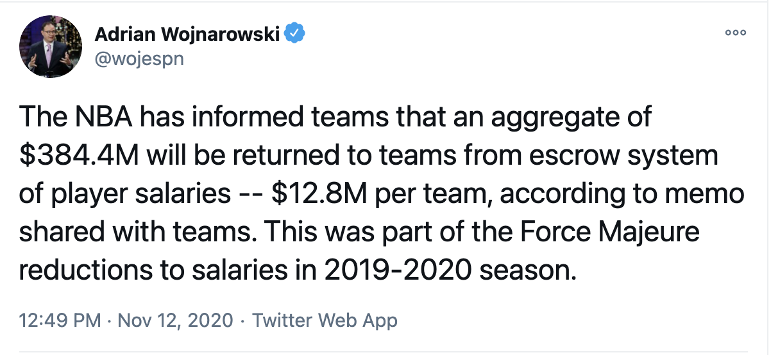LEAGUE CAP RULES
The NBA Collective Bargaining agreement is the backbone of all basketball operations. Business cannot be conducted in any structured environment without a set of rules to govern decision making among all involved parties. In this section, we will attempt to break down some of the most frequently used terms and provide examples so that you may better understand some of the overarching terms of the league’s cap system.
1) Collective Bargaining Agreement
2) Salary Cap
3) Luxury Tax
4) Bird Rights
5) Cap Holds
9) Exceptions
10) Incentives
11) Escrow
2024-2025 Salary Cap:
$140.5 Million
2024-2025 Luxury Tax:
$170.8 Million
2024-2025 1st Apron:
$178.1 Million
2024-2025 2nd Apron:
$188.9 Million
Collective Bargaining Agreement
The Collective Bargaining Agreement serves as the backbone for all of the rules and regulations for the NBA. It is a formal agreement between the Players Association and the League that specifies how teams and their players can go about conducting negotiations, making signings, receiving payments, etc. Play during a season cannot commence until there is a formal agreement in place. Each agreement lasts a predetermined amount of time, typically several years, although each side has the opportunity to opt-out the year before the end of the term.
e.g. Both sides agreed that the players’ share of Basketball Related Income (BRI) will remain in the 49%-51% band.

Salary Cap
Easy to understand, but difficult to master, the NBA utilizes a salary cap system that puts limits on how much money each of the thirty teams are allowed to spend in any given year. The salary cap is set on July 1st of each calendar year (under normal circumstances) based on the amount of ‘Basketball Related Income’ the league took in the prior season. BRI takes into account several revenue streams like broadcast rights. Once BRI has been determined, a specific formula is used for calculation of the cap. The NBA uses a ‘soft’ cap system that allows teams to exceed a predetermined threshold. This system gives teams an outlet to sign extra players and retain free agents via ‘bird rights’ (see below) even if they are over that cap number.
e.g. The official salary cap number was set at $136.021 million for the 2023-2024 NBA season. Other financial thresholds were set on June 30, 2023, such as the luxury tax total, the minimum team salary, and the mid-level exceptions.

Luxury Tax
NBA teams begin to get penalized or taxed based on how far over the salary cap a team’s payroll goes. This upper spending limit is also determined during the offseason using a particular percentage of BRI. From there, teams begin to incur penalties for each dollar they spend over the previously established tax threshold. Furthermore, these penalties increase based on a ‘tiered’ system that breaks penalties down into ranges. However, a team’s final luxury tax payment does not become official until the end of the regular season. So if a team begins the season over the tax line, they can still make moves during that season to bring their total payroll below the line, so that they can reduce or completely eliminate any luxury tax payments.
Teams that finish the season above the tax level 3 out of the four salary cap years before the current year are subject to the repeater tax. This means that they are taxed at even higher rates than they otherwise would be.
The tax bracket began at $5 million over the tax. Starting in the 2024-2025 tax year however, the brackets will increase at an amount equal to the increase in the salary cap.
e.g. The luxury tax threshold for the 2023-2024 campaign was set to $165 million. The Golden State Warriors ended their season over the tax by $59.8 million. That placed them into the 4th tier tax penalty, which covers 400% of the tax bracket and above. They are also a repeater tax team, which increases their penalties further. They were taxed at a rate of $4.25 on the dollar which applies to teams spending 300% – 400% of the tax bracket amount, then an additional $0.50 for each additional 100% of the tax bracket amount since they were 500% over the tax bracket amount.
That placed them into the fourth ‘tax bracket’, which covers $20,000,000+. They were taxed at a rate of $3.75 on the dollar, then an additional $0.50 for each $5 million after, which amounted to an additional $2.00 per dollar spent, for a total of $5.75 per dollar spent over the tax line.
Bird Rights
Each team eventually has to deal with prized players hitting free agency, which introduces the risk of them leaving for another team. In order to reward the incumbent team and give them an advantage when it comes to re-signing their player and avoiding losing them for nothing, the league grants that team what’s called ‘Bird Rights’ for that player. This gives them the right to re-sign a player who has been on their roster for at least two seasons using enhanced spending power that isn’t available to any other team. This term can be further broken down into ‘early bird’ rights and ‘full bird’ or ‘Larry Bird’ rights. Early Bird covers players who have been on a roster for two years. Once a player has played with a team for three seasons, that team can claim full bird rights. The benefit of Full Bird rights is that it allows a team to retain a player using a greater percentage of his previous season salary.
e.g. Tyrese Haliburton was extended by Indiana in May of 2023 after his third full year with the Pacers. This gave the team full Bird Rights to him and the ability to sign him using the Larry Bird Exception. They proceeded to sign him to a five-year, $244 million rookie extension. He made All-NBA in 2023-2024, so he will earn the full 30% of the 2024-2025 salary cap, which amounts to $42 million in his first season.

Cap Holds
Cap holds act as placeholders on each team’s cap sheet to indicate upcoming free agents or draft picks. Cap holds are put in place to prevent teams from having room under the cap to sign free agents before using Bird Rights on their own free agents. Cap hold amounts are determined based on how that player was signed under his previous contract. The cap hold can be as high as 300% of the previous salary for first round picks coming off of their rookie deals, to as low as a one-year veteran’s minimum salary for players on a minimum deal.
e.g. Dyson Daniels will earn $7,707,709 in the 2025-2026 season if his team option is exercised. The Hawks will have Full Bird rights on him (3+ years on the team inherited from Pelicans via trade), which brings his cap hold for 2024 to 300% of his previous salary, or $23,123,127.

Restricted Free Agent
Certain players are eligible for this type of free agency in particular situations. If a player is a 1st round pick coming off of their 4th year in the league, ortheir team option was not picked up by their team following their 2nd or 3rd season, they enter Restricted Free Agency. This also applies to Two Way players who were on a NBA roster at some point in the preceding season. This means that their team has the ‘right of first refusal’, which gives said team the power to match any contract offer made to that player by another team.
Unrestricted Free Agent
Most players enter Unrestricted Free Agency once their contract expires, or a player/team option is not exercised. This means that there are no restrictions on that player and they are free to sign with any team, granted that team has the monetary means to do so. If the team they were on at the end of their contract has Bird Rights, they are able to offer more years and money than other teams, but don’t have the right to match offers like in Restricted Free Agency.
Early Termination Option
An Early Termination Option is a rare option given to players that allows them to terminate the final year of their contract, which can’t be prior to year 4. This option is only permitted in full five year contracts.
Exceptions
Exceptions are a product of the ‘soft cap’ system used by the league. Teams that spend over the season salary cap are given access to additional ways to sign players. Even teams re-signing their own free agents using Bird Rights are digging into an exception, since they are technically exceeding the cap to do so. It’s important to keep in mind however, that not all teams have access to all exceptions. The bi-annual exception for instance is not available to a team if they have used it in the previous year. The rookie exception can be used to re-sign a player like Jaylen Brown or Pascal Siakam to a max deal, while the minimum exception is commonly used to sign end of rotation players to a cheap one year deal. These are typically worth $1 million to $2 million. The value of these exceptions also change from year to year, as they are tied directly to what the salary cap is set to for a particular season.
e.g. In July of 2024, the Dallas Mavericks signed Naji Marshall to a 3 year, $27 million contract using their Mid-Level Exception, which they could utilize, even though they were already above the salary cap line.
![]()
Incentives
During contract negotiations, players have the opportunity to build in bonuses based on meeting or exceeding certain benchmarks agreed upon by both sides. These benchmarks cannot be arbitrary and must fall under certain umbrellas, such as physical achievement, or performance. Performance based goals can be centered on the player (shooting a certain percentage from three on the season), or the team (reaching the Eastern Conference Finals). They can also be categorized in two different ways: likely and unlikely. ‘Likely’ means the benchmark was reached in the previous season, while unlikely means that it was not. The value of these incentives must not exceed 15% of the total value of a players’ contract for a given season. Certain contracts are ineligible for incentives or bonuses, such as minimum salary contracts.
e.g. Clint Capela was eligible for $2 million in bonuses for the 2020-2021 season. They included $1M for making the Western Conference Finals + playing 2,000 minutes in the regular season, $500k for shooting 65% or better from the free throw line, and $500k for hitting a defensive rebounding percentage of 30%. None of these marks were accomplished in the season prior, so they were classified as ‘unlikely bonuses.’
Escrow
The Escrow System is meant to prevent players from earning more money than their split of BRI guarantees them. The league withholds ten percent of player salaries each season under normal conditions (25% in 2019-2020 due to COVID-19) in case revenues fail to meet projections. If the players earned more than their split of BRI, the escrow money is given back to the teams and players receive a share if there is any left over.
e.g. For the 2019-2020 season, $384M was returned to the teams from the escrow system due to the success of the NBA Bubble.

For a comprehensive look at these cap rules and many more detailed principles, be sure to reference Larry Coon’s invaluable CBA FAQ website here: http://www.cbafaq.com/salarycap.htm
*Example screenshots obtained via the NTC Atlanta Hawks + San Antonio Spurs + Philadelphia 76ers Cap Sheets, Adrian Wojnarowski, nbpa.com and official league sources.
